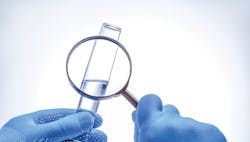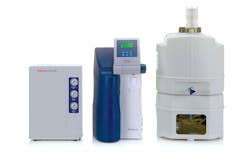Targeting clean water with new technology
Clean water touches every aspect of the pharmaceutical process. It acts as a solvent, excipient and reagent in the production of safe, effective medicines, and underpins the development of nutraceuticals, botanicals, enzymes and personal care products.
However, water quality is changing on a global scale as new chemical and biological impurities are introduced into water supplies from various sources, including industry, health care and agriculture. Perhaps surprisingly, commonly used treatment processes are adding to this problem, with water chemistry becoming more complex as chemistry-based treatment processes are more widely implemented. As industrial water use continues to rise along with rapid and ongoing industrialization worldwide, the chemical complexity of water is set to increase.
Staying abreast of the ever-changing array of contaminants found in waterways and municipal supplies is therefore an evolving challenge in drug discovery, development and manufacture. It requires innovative approaches to water management — and new technologies for efficient water purification.
An industry under strain
The pharma industry runs on water. For example, water constitutes a high percentage of the reaction mixtures and buffers used in clinical assays. It is an essential component of most reagent solutions and is used intensively throughout manufacturing and production.
However, not all water is used equally. Each pharmaceutical procedure, from rinsing glassware to chromatography, has specific water quality requirements. While not all processes require intensively purified water, each is sensitive to particular impurities, from suspended particles to inorganic ions to dissolved gases. Contaminants can hinder experimental analyses by interfering with operation, retarding cell and tissue growth, fouling resins and membranes, and more. Impure water, therefore, runs the risk of adversely affecting the accuracy, reliability and consistency of results that really matter (those needed to develop a much-needed new medicine, for instance).
Guaranteeing that laboratory water is appropriately pure and fit for purpose is a critical prerequisite for developing effective products that are safe for use. However, removing contaminants from municipal supplies is far from easy. Water treatment processes are time-consuming and expensive, and lock-up valuable resources within pharmaceutical development pipelines that are facing pressure to move faster, save money and be ever-more efficient.
As contaminants become increasingly prevalent in water supplies and their chemistries grow more complex, municipal water supplies must be subjected to more intensive and comprehensive purification processes than ever before. This poses a significant challenge to the pharma industry that already possess limited resources, as it threatens to extend timelines and add further cost to drug development efforts. To overcome such hurdles, companies require innovative alternative ways to efficiently and effectively purify their water supplies.
Water purification challenges
Pharma companies employ various treatment and monitoring processes to ensure water is appropriately pure. However, traditional purification techniques are either limited in efficacy, or introduce reagents that must later be removed.
Many treatment processes involve a “purifying” chemical reagent. A prominent example of this is chlorination, which works by introducing chlorine-based disinfectants into municipal water. These substances neutralize biological contaminants and oxidize organic compounds, but also produce additional biochemistries in the process. The reagent and its byproducts must, therefore, be removed before water is safe for experimental use, as they can have adverse effects on pharma research and are potentially harmful to the human body if consumed in high doses.
Another approach to water treatment utilizes functionalized materials to purify municipal supplies — key examples being activated carbon, natural clay minerals and silica gel. Such materials are used to dechlorinate and remove other impurities from water, using a mix of adsorption and catalytic conversion processes. While they bring benefits by not producing troublesome byproducts, functionalized materials are limited in the amount of contaminants they can remove. The presence of certain organic compounds can also chemically or physically curtail their efficiency (via poisoning or by physically blocking their pores, for example).
Innovative water management solutions
In an environment where water chemistries and contamination threats can emerge and evolve rapidly, the pharma industry must be equipped with robust, reliable technologies for water management. Fortunately, new developments in this area hold promise, building upon existing techniques to offer solutions that meet the sector’s diverse and growing needs.
Increasingly advanced filtration technologies are emerging based on graphene, which can overcome many of the limitations of functionalized materials. Graphene is resistant to chemical poisoning and fouling, and is able to hold on to impurities for longer timescales due to its greater surface area (without getting blocked in the process). Graphene filtration “sieves” hold immense potential for desalination applications, and have proven able to remove common salts, nano- and organic particles from water.
Based on this technology, it may soon be possible to fabricate graphene-oxide membranes with precise pore sizes that can be refined at an atomic scale. Such scalability and control could bring on-demand sieving technologies capable of filtering specific impurities by size.
Alternatively, methods based on electrochemistry offer numerous benefits over workflows that traditionally use purifying reagents. Electrochemical technologies reliably purify water by generating short-lived chemicals and oxidants that have no subsequent impact on a wide array of pharmaceutical applications, and thus do not need to be removed. This chemically benign process of purification reduces the cost and complexity of intensive chemical treatment, and produces water to a high level of quality suitable for use in even the most sensitive of pharma applications.
Benefits of synergistic purification
Water often requires a multi-step process to reach a desired purification level. Different pharma companies have highly specific needs for their laboratory water, and often encounter different levels and types of contaminants in their incoming supply (dependent on geography, surrounding industrial activity and other factors). Combining multiple technologies for purification brings flexibility and efficiency to the pharmaceutical pipeline, enabling companies to avoid contaminated laboratory water and produce a supply that is appropriate for their applications across analytical, life science and general lab purposes.
Alongside the development and optimization of innovative water purification techniques themselves, new systems are available that synergistically bring together multiple electrochemical technologies in a single step — for example, combining ultraviolet oxidation and ultrafiltration. Together, these techniques can remove organics, particles, bacteria, pyrogens and nucleases to a high degree, producing water suitable for highly sensitive uses, and maximizing the efficiency and efficacy of the purification process.
Protecting the lifeblood
Water is the lifeblood of the pharmaceutical industry. It is used as a raw material, ingredient, solvent and reagent throughout manufacturing, production and packaging. Sourcing water of appropriate quality for these diverse applications is becoming increasingly challenging as industrial and scientific activities introduce an ever-changing array of complex contaminants into global water supplies. Fortunately, pharmaceutical companies can overcome this challenge, and associated financial and operational hurdles, by using innovative, synergistic point-of-use technologies to optimize water management.

